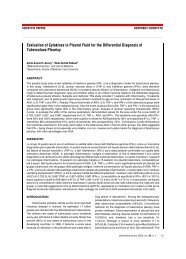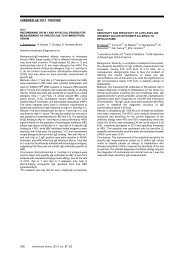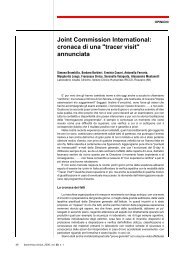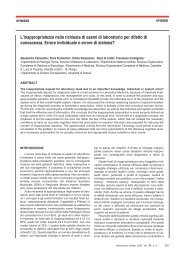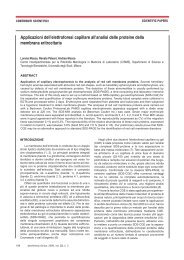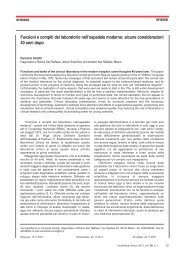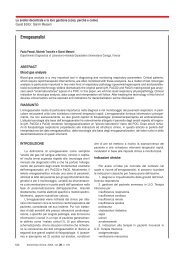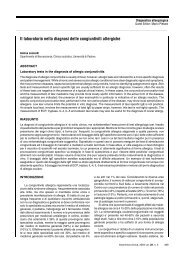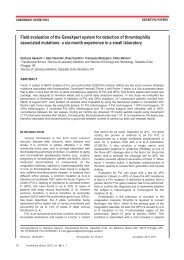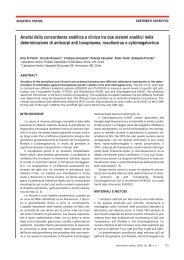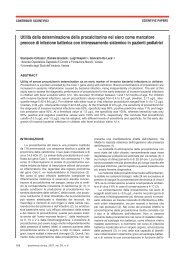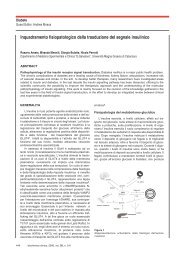699-704_Binding Site Italia Award_Sessioni sponsorizzate - SIBioC
699-704_Binding Site Italia Award_Sessioni sponsorizzate - SIBioC
699-704_Binding Site Italia Award_Sessioni sponsorizzate - SIBioC
Create successful ePaper yourself
Turn your PDF publications into a flip-book with our unique Google optimized e-Paper software.
EuroMEdLab 2013 - “ThE binding siTE iTaLia” awardBS05MEASUREMENT OF CIRCULATING FREE LIGHT CHAINAND CARDIAC BIOMARKERS IDENTIFIES PATIENTSWITH AL AMYLOIDOSIS AT VERY HIGH RISK OF EARLYDEATHP. Milani, G. Palladini, A. Foli, L. Obici, F. Lavatelli, M.Nuvolone, G. MerliniAmyloidosis Research and Treatment Center, “FondazioneIstituto di Ricovero e Cura a Carattere Scientifico (IRCCS)Policlinico San Matteo”, and Department of MolecularMedicine, University of Pavia, ItalyBackground:The ability to accurately identify patients with ALamyloidosis at high risk of early death is crucial in the designof treatment strategy. A staging system based on aminoterminalpro-natriuretic peptide type-B (NT-proBNP) andtroponins (cTn) is currently used for prognostic stratification.Recently, the measurement of FLC has been incorporated inthis staging system. We prospectively assessed the prognosticrole of measurement of FLC and cardiac biomarkers in 531consecutive newly diagnosed patients enrolled between 2004and 2010.Methods and results: Serum FLC concentration was measuredby the <strong>Binding</strong> <strong>Site</strong> assay on a BN ProSpec nephelometer.Median age was 65 years. 393 (74%) patients had cardiacinvolvement by standard diagnostic criteria. Mayo cardiac stagewas I (NT-proBNP
EuroMEdLab 2013 - “ThE binding siTE iTaLia” awardBS07NEGATIVE PREDICTIVE VALUE OF SFLC IN DOUBTFULHISTOLOGICAL PATTERNM. Seguso (1) , S. Altinier (1) , M. Zaninotto (1) , M. Varagnolo (1) ,F. Lessi (2) , F. Adami (2) , M. Plebani (1)1 Department of Laboratory Medicine, University-Hospital ofPadova, Italy2 Department of Clinical & Experimental Medicine,Hematology & Clinical Immunology Section, University-Hospital of Padova, ItalyMethods: In January 2011 a 48-year-old Chinese woman wasadmitted due to back pain. Laboratory examination showedmild anemia (Hb=119 g/L) and a mild increase of acute phaseproteins; immunofixation electrophoresis was negative; κ andλ serum Free Light Chains (sFLCs) were 2.80 and 7.91 mg/L,respectively; creatininemia was 29 umol/L; Quantiferon testwas negative. Magnetic Resonance (MR) of the spine showeddiffuse multiple substitutive lesions. A Positron emissiontomography-computed tomography scan was consistent withmultiple glucose-avid lesions at the whole spine, sternum andpelvis level. A bone marrow biopsy showed 10% clonal plasmacells. The cytogenetic investigation was normal. The body ofthe 2nd lumbar vertebra was biopsied and showed clonalplasma cells, consistent with plasma cell neoplasia.Results: A non-secretory multiple myeloma was diagnosed.The patient underwent chemotherapy according toLenalidomide-Dexamethasone regimen, but a subsequent MRshowed progression of the disease. Serum and urineimmunofixation was negative; sFLC concentrations rangedfrom undetectable to 10.3 mg/L, κ/λ ratio ranged from 0.35 to1.17 and did not change over the time. The patient underwentunsuccessful radiation therapy of the spine (T7-T11 and L3-L4). Because of refractory disease, a D8-D9 laminectomy withmultiple biopsies was performed: the histologic diagnosis wasstill consistent with plasma cell neoplasia. The patientunderwent sequential unsuccessful chemotherapies. Thehistologic specimens were reviewed elsewhere and thediagnosis was consistent with probable metastasis of primaryunknown cancer. The patient underwent a surgical iliac bonebiopsy. Mycobacterium tuberculosis was shown both oncultural and molecular grounds. Interestingly, the Quantiferontest became positive. Eventually a diagnosis of Pott’s diseasewas made. Abnormal sFLC ratio identifies a high proportion(68% to 100%) of non-secretory multiple myeloma patients. Inour patient despite anemia, bone lesions and several histologicdiagnosis of clonal plasma cell disease, sFLC concentrationswere always
EuroMEdLab 2013 - “ThE binding siTE iTaLia” awardBS09SLOW RENAL FUNCTION RECOVERY AFTER ACUTEKIDNEY INJURY IN A CASE OF MYELOMA KIDNEY:ROLE OF FREE LIGHT CHAIN MONITORINGG. Grandi (1), F. Bergesio (2) , C. Nozzoli (3) , A. Terreni (1) , T.Biagioli (1) , G. Avveduto(1), M. Brogi (1) , G. Ghiandai, (2) , E.Dervishi (2) , E. Buti (2) , A. Caldini (1)1 Laboratorio Generale, Azienda Ospedaliero UniversitariaCareggi, Florence, Italy2 Nefrologia e Dialisi, Azienda Ospedaliero UniversitariaCareggi, Florence, Italy3 Ematologia, Azienda Ospedaliero Universitaria Careggi,Florence, ItalyBackground: Up to 10% of patients with myeloma developsacute kidney injury (AKI) which requires dialysis support.Unless fast reduction of toxic free light chain (FLC) is achievedby means of aggressive chemotherapy (CT) coupled to highcut-off membrane hemodialysis (HCO-HD), most of thembecome dialysis dependent.Methods: A 66 year woman, on follow-up for IgG λ smoulderingmyeloma (40% λ monotypic plasma cells), was admitted at ourhospital for AKI. Laboratory findings were as follows: serumcreatinine (sCr) 9.8 mg/dL; IgG λ monoclonal component (MC) 1.05 g/dL , FLCλ 16160 mg/L, κ/λ 0.0014 and Bence Jonesλ 156 mg/24 h. Renal biopsy confirmed “cast nephropathy” andthe patient started dialysis with HCO-HD (Theralite 2100Gambro; 6 hours /3 times a week) in addition to Bortezomiband Dexamethasone according to a biweekly schedule (4cycles) plus Thalidomide treatment. FLC concentrations weremeasured by nephelometry (Freelight <strong>Binding</strong> <strong>Site</strong>; BeckmanImmage 800) in blood samples collected at 5,180 and 360 min.Results: Dialysis independence( sCr 5.2 mg/dL) was achievedafter 10 dialysis sessions and a very good partial hematologicalresponse after 2 cycles of CT with a remarkable low value ofFLCλ (33.9 mg/L). After two subsequent cycles of CT, sCr wasreduced to 2.5 mg/dL, CM to 0.14 g/dL, FLCλ to 12.7 mg/L andthe absence of clonal cells in bone marrow was documented.One month later the patient underwent high dose CT in view ofautologous stem cell transplantation.After 6 months thehematological response was stable (FLCλ 18.3 mg/L) andrenal function was further improved (sCr 1,9 mg/dL).Conclusions: In the short-term HCO-HD was more effective onFLC levels (99% reduction), than on sCr (47% reduction), butthe present case shows that, even after CT interruption, renalfunction may further improve. The observed slow renalrecovery may be caused by the slower clearance ofpathological FLC from kidney, due to the potential uniquebiochemical characteristics of these high variable molecules.FLC monitoring seems to be an useful tool to guide extent ofHCO-HD, tailoring treatment of single myeloma kidney patient.BS10THE RELEVANCE OF SERUM FREE LIGHT CHAINMONITORING IN IGD KAPPA MULTIPLE MYELOMAMENAGEMENTE. De Santis (1) , G. Cigliana (1) , I. Cordone (1) , S. Masi (1) , F.Pisani (2) , L. Dessanti (2) , E. Curti (1) , G. Illuminati (1) , L. Conti (1)1 Clinical Pathology IRE, National Cancer Institute ‘ReginaElena’, Rome2 Haemathology and Transplantation, National CancerInstitute ‘Regina Elena’, RomeBackground: The IgD Multiple Myeloma (MM) is a rare diseasealmost exclusively Ig Lambda Chains restricted. In this reportwe describe a case of IgD Kappa MM.Methods: A 51 y/o woman with anaemia and bone lesions wasadmitted in our Institute. A Bence Jones (BJ) positive Kappalight chain in the urine and a serum free light chain ratio of709.5 with Kappa free 5889 mg/L and Lambda free 8.3 mg/Lvalues, was documented. The plasmacell (PC) flow cytometrycharacterization identified an infiltration (23% of bone marrowpopulation) of CD38, CD138, CD28, CD56, CD117 positive,CD45 CD19 negative tumour plasmacells, with Kappa free lightchains (FLC) restriction. Patient was treated with 2 cycles ofVincristine, Adriblastine, Dexamethasone (VAD), 2 cycles ofEndoxan and 2 cycles of Bortezomib, Myocet, Dexamethasone(BMD). Response to treatment was monitored with Kappa /Lambda free light chains ratio, bone marrow (BM) trephine andplasmacell flow cytometry. A high serum level of Kappa FLC,with an abnormal FK/FL ratio was documented, supported bya tumour PC immunophenotype, confirming no treatmentresponse. An autologous stem cell transplantation (autoSCT)was performed.Results: The FLC monitoring identified a progressive K/L ratioreduction as well as an increase of CD45 CD19 positive, CD56CD117 negative normal BM PC, leading to a near CompleteRemission (nCR).Conclusions: IgD Kappa MM are seldom reported in theliterature. In this case report, we describe the relevance of anon invasive approach, the FLC Kappa and Lambda ratio, indisease monitoring and in the identification of lack of treatmentresponse. FLC appears to be an important and crucial tool forclassification of responders and non responders and coulddeeply contribute to a better management of MM patients.biochimica clinica, 2013, vol. 37, SSS703
EuroMEdLab 2013 - “ThE binding siTE iTaLia” awardBS11THERAPY MONITORING WITH “FREELITE” ASSAY IN APHARMACORESISTANT MICROMOLECULARMYELOMAL. Paolini, G. Di Noto, D. RicottaDept. Molecular and Translational Medicine, Faculty ofMedicine, University of BresciaMethods: A 78-years-old man was admitted to hospital withstrangury, fever and dyspnea in Nephrology ward. AbdomenCT scan and echography were all unremarkable. Urine testshowed proteinuria (7.9 g/L in 24 h), but normal renal function.Serum and urine immunofixation showed a faint monoclonal λband. Serum Freelite assay was performed and showed anabnormal κ/λ ratio =0.0008 (κ 1.52 mg/L, λ1890 mg/L)indicating a monoclonal component of λ free light chain (FLC).This abnormal values highlighted the suspect of myeloma andnephrologists prescribed a osteo-medullary biopsy thatrevealed aggregates of plasmacytosis, accounting for 20% ofthe marrow cellularity; the cellular aggregates stained positivelyfor λ FLC and negatively for κ FLC. Periumbilical fat wasnegative at Congo red staining indicating no amyloidogenic λFLC.Results: The patient diagnosis was II A λ micromolecularmyeloma and treatement with bortexomib, melphalan andprednisone was started. During the following days κ/λ ratio wasstill altered indicating therapy failure. A week later heexperienced anury and Lab tests showed acute renal failurewith blood creatinine increasing (13 mg/dL) without obstructionof excretory apparatus and increase of λ FLC in serum (κ 0.42mg/L, λ 4540 mg/L). According to nephrologists andhematologists advices the patient began with bicarbonate 1/6M and mannitol against the cast nephropathy and parenteraldesametasone 20 mg/die. The therapy did not show any effect:λ values were still high with anuria. Freelite assay helped todefine the best therapy: clinicians decided to suspendpharmacological therapy and to dialyze the patient with PMMAfilters (6 h treatment, changing filter every 2 h) to remove FLCfrom the serum. Every 2 h Freelite assay was performed tofollow-up proteins removal. After 6 h FLC concentrationdecreased (κ 0.5 mg/L, λ 534 mg/L), diuresis was restored andrenal function was improved (creatinine 1.7 mg/dL). Themyeloma treatment was established with steroids because oflenalidomide treatment patient incompliance and, after kidneyrecovery, the dialysis was suspended.Conclusions: Freelite assay helped laboratorists to highlightthe suspect of myeloma and helped nephrologists andhematologists to define the best therapy and patient follow-upprocess.BS12USEFULNESS OF SERUM FREE LIGHT CHAIN ASSAYFOR DIAGNOSIS AND THERAPEUTIC MONITORING OFPLASMA CELL DISORDERS: A CASE REPORTF. de Liso (1) , N. Failla (1) , C. Novembrino (1) , R. Maiavacca (1) ,L. Baldini (2)1 Laboratory of Clinical Chemistry and Microbiology,Fondazione IRCCS Ca’ Granda Ospedale MaggiorePoliclinico, Milan, Italy2 Division of Hematology, Fondazione IRCCS Ca’ GrandaOspedale Maggiore Policlinico, Milan, ItalyBackground: According to the International Myeloma WorkingGroup guidelines, serum Free Light Chain (FLC) assay can beused for evaluation and management of plasma cell disorders.Methods: We report the case of a 40 year-old woman whoarrived at our department with the following clinical history:progressively increased serum creatinine value (from 1.0 to 2.8mg/dL) and non-selective glomerular proteinuria (1-2 g / 24 h)starting from 32 week of pregnancy; transitory reduction ofcreatinine value after treatment with Metilprednisolone (40mg/die) for pre-sacral pain (no lesions evidenced by X-Ray);delivery at 35 week and rising of creatinine value (3 mg/dL)and proteinuria (2.5 g / 24 h) after metilprednisolone reduction;electrophoresis and immunofixation displaying k FLC with noevidence of osteomedullary alteration.Results: In order to exclude a plasma cell disorder, patient washospitalized and biochemical evaluation evidenced: serumcreatinine (1.24 mg/dL), hemoglobin (12 g/dL), non-selectiveglomerular proteinuria (3 g/dL), elevated serum k FLC level(1176 mg/L, measured by turbidimetric method, Freelite, The<strong>Binding</strong> <strong>Site</strong> Ltd, Birmingham, UK; reference interval: 3.3-19.4mg/L) with consequent abnormal FLC κ/λ ratio (79.5; referenceinterval 0.3-1.2). Serum and urinary immunofixation confirmedthe presence of κ FLC. Renal biopsy revealed a castnephropathycondition due to κ FLC deposition. Furtherinvestigations were conducted: total body PET was negative;backbone NMR highlighted a wide replacement of pre-sacralregion with pathological tissue characterized by plasma cellinfiltration (CD138+, CD56+, CD20-) with low proliferative index(ki67




